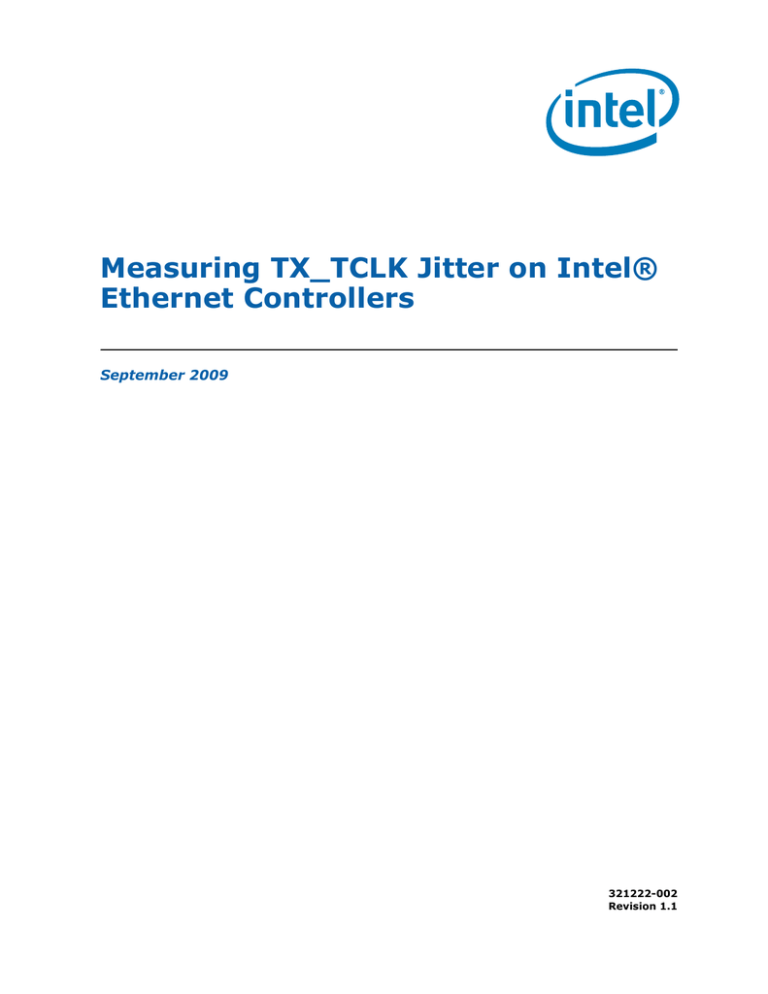
Measuring TX_TCLK Jitter on Intel®
Ethernet Controllers
September 2009
321222-002
Revision 1.1
INFORMATION IN THIS DOCUMENT IS PROVIDED IN CONNECTION WITH INTEL® PRODUCTS. NO LICENSE, EXPRESS OR IMPLIED, BY ESTOPPEL OR
OTHERWISE, TO ANY INTELLECTUAL PROPERTY RIGHTS IS GRANTED BY THIS DOCUMENT. EXCEPT AS PROVIDED IN INTEL'S TERMS AND CONDITIONS
OF SALE FOR SUCH PRODUCTS, INTEL ASSUMES NO LIABILITY WHATSOEVER, AND INTEL DISCLAIMS ANY EXPRESS OR IMPLIED WARRANTY, RELATING
TO SALE AND/OR USE OF INTEL PRODUCTS INCLUDING LIABILITY OR WARRANTIES RELATING TO FITNESS FOR A PARTICULAR PURPOSE,
MERCHANTABILITY, OR INFRINGEMENT OF ANY PATENT, COPYRIGHT OR OTHER INTELLECTUAL PROPERTY RIGHT. Intel products are not intended for
use in medical, life saving, life sustaining, critical control or safety systems, or in nuclear facility applications.
Legal Lines and Disclaimers
Intel may make changes to specifications and product descriptions at any time, without notice.
Intel Corporation may have patents or pending patent applications, trademarks, copyrights, or other intellectual property rights that relate to the
presented subject matter. The furnishing of documents and other materials and information does not provide any license, express or implied, by estoppel
or otherwise, to any such patents, trademarks, copyrights, or other intellectual property rights.
IMPORTANT - PLEASE READ BEFORE INSTALLING OR USING INTEL® PRE-RELEASE PRODUCTS.
Please review the terms at http://www.intel.com/netcomms/prerelease_terms.htm carefully before using any Intel® pre-release product, including any
evaluation, development or reference hardware and/or software product (collectively, “Pre-Release Product”). By using the Pre-Release Product, you
indicate your acceptance of these terms, which constitute the agreement (the “Agreement”) between you and Intel Corporation (“Intel”). In the event
that you do not agree with any of these terms and conditions, do not use or install the Pre-Release Product and promptly return it unused to Intel.
Designers must not rely on the absence or characteristics of any features or instructions marked “reserved” or “undefined.” Intel reserves these for
future definition and shall have no responsibility whatsoever for conflicts or incompatibilities arising from future changes to them.
Intel processor numbers are not a measure of performance. Processor numbers differentiate features within each processor family, not across different
processor families. See http://www.intel.com/products/processor_number for details.
The Ethernet Controllers described in this document may contain design defects or errors known as errata which may cause the product to deviate from
published specifications. Current characterized errata are available on request.
Hyper-Threading Technology requires a computer system with an Intel® Pentium® 4 processor supporting HT Technology and a HT Technology enabled
chipset, BIOS and operating system. Performance will vary depending on the specific hardware and software you use. See http://www.intel.com/
products/ht/Hyperthreading_more.htm for additional information.
Contact your local Intel sales office or your distributor to obtain the latest specifications and before placing your product order.
Copies of documents which have an ordering number and are referenced in this document, or other Intel literature, may be obtained from:
Intel Corporation
P.O. Box 5937
Denver, CO 80217-9808
or call in North America 1-800-548-4725, Europe 44-0-1793-431-155, France 44-0-1793-421-777, Germany 44-0-1793-421-333, other Countries 708296-9333.
Intel and Intel logo are trademarks or registered trademarks of Intel Corporation or its subsidiaries in the United States and other countries.
*Other names and brands may be claimed as the property of others.
Copyright © 2009, Intel Corporation. All Rights Reserved.
2
Measuring TX_TCLK Jitter—1 GbE Controllers
Revision History
Date
Revision
Description
September 2009
1.1
Fixed two typos.
December 2008
1.0
Initial public release.
3
1 GbE Controllers—Measuring TX_TCLK Jitter
Note: This page intentionally left blank.
4
1 GbE Controllers—Measuring TX_TCLK Jitter
1.0
Introduction
Self certification for IEEE standards can be a difficult undertaking. Companies such as
Tektronix and Agilent offer test suites to provide early compliance reports for Ethernet
designs. One test, outlined in Clause 40.6.1.2.5 of IEEE 802.3, requires that designers
inspect an internal clock (TX_TCLK) for jitter content. This application note describes
an alternative method for measuring this clock for Intel Ethernet controllers that do not
make this clock externally available for inspection.
2.0
Scope
This document outlines why Intel does not make the TX_TCLK available on most of its
Ethernet controllers, where to find documentation regarding an approved alternative
method of measuring the jitter of this clock, and provide the reader with the location of
further IEEE 802.3 testing documentation available from the University of New
Hampshire.
3.0
Why is TX_TCLK Not Available on Certain Intel
Ethernet Controllers?
TX_TCLK is often not found externally available on Intel Ethernet controllers.
Since this is the internal clock that is used to drive MDI signals, it is by design a clean
clock. When designers take this clean, internal clock and try and expose it to the rest
of the world, there is the additional cost and complexity associated with adding a lowjitter driver for the test clock. Also, bringing this clock out to the ball or lead of a
package can also change the characteristic of the original clock as well as the measured
clock.
4.0
What is the Alternative Method for Measuring
TX_TCLK?
See Appendix 40.B Transmitter Timing Jitter, No TX_TCLK Access: ftp://ftp.iol.unh.edu/
pub/ethernet/test_suites/CL40_PMA/PMA_Test_Suite_v2.5.pdf.
The appendix indirectly measures the jitter of the 125 MHz clock. The premise is the
TM2/TM3 jitter signal is driven by TX_TCLK. Note that TX_TCLK jitter is included in the
measurement. If the TM2/TM3 signal jitter passes, which includes TX_TCLK jitter as
well as any jitter that is added by the Analog Front End (AFE) or coupled in from the
system, then the TX_TCLK indirectly passes the jitter test.
5
Measuring TX_TCLK Jitter—1 GbE Controllers
5.0
Is TX_CLK the Same Clock as TX_TCLK?
No, TX_CLK is different clock in a different clock domain than TX_TCLK. TX_CLK is the
clock found between the Media Access Controller (MAC) and the PHY used over the
GMII interface. TX_TCLK is the 125 MHz clock that drives the internal transmitters,
BI_DA, BI_DB, BI_DC, and BI_DD, that generate the five-level PAM signal that drives
the signal out to the magnetics.
6.0
Where Can I Find More Information?
The University of New Hampshire maintains the Interoperability Labs (IOL) for the
gigabit Ethernet standard.
6

